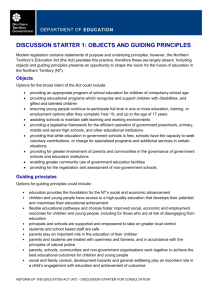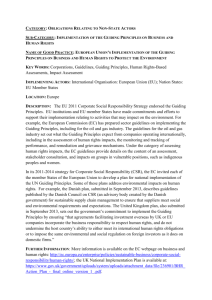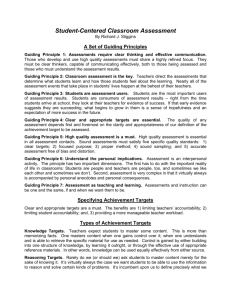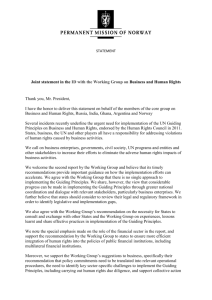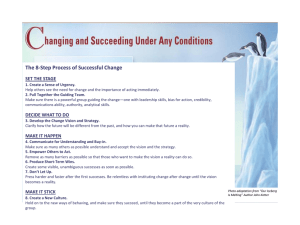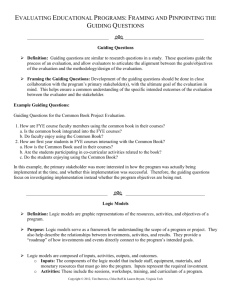Human rights policies and practice – 10 questions for companies
advertisement
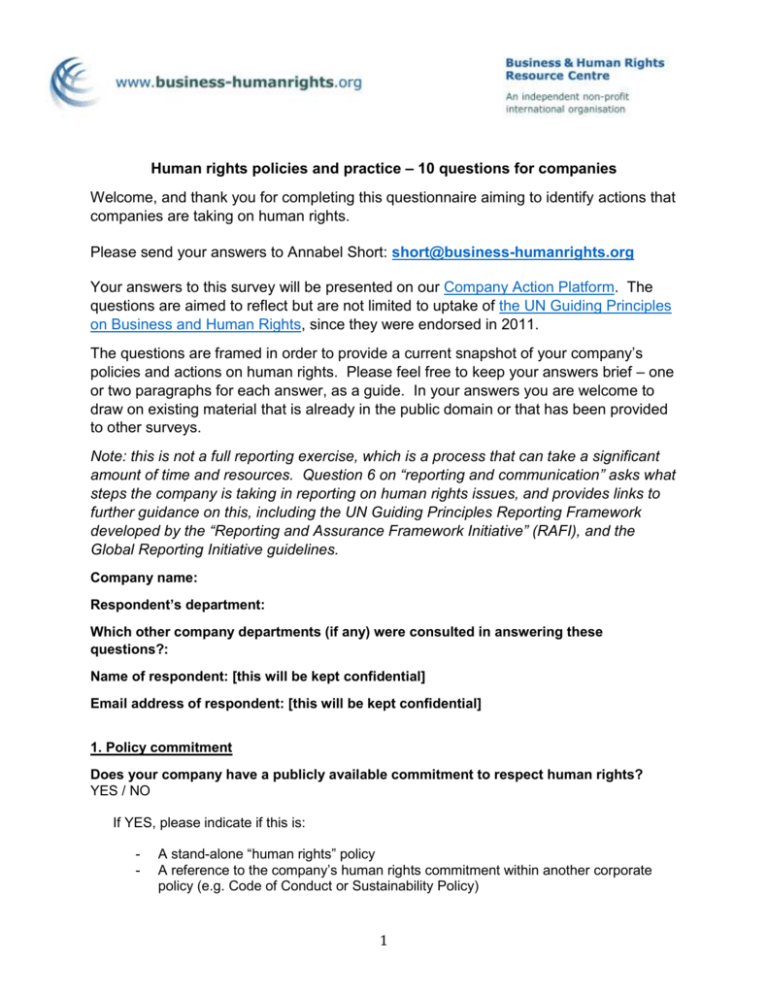
Human rights policies and practice – 10 questions for companies Welcome, and thank you for completing this questionnaire aiming to identify actions that companies are taking on human rights. Please send your answers to Annabel Short: short@business-humanrights.org Your answers to this survey will be presented on our Company Action Platform. The questions are aimed to reflect but are not limited to uptake of the UN Guiding Principles on Business and Human Rights, since they were endorsed in 2011. The questions are framed in order to provide a current snapshot of your company’s policies and actions on human rights. Please feel free to keep your answers brief – one or two paragraphs for each answer, as a guide. In your answers you are welcome to draw on existing material that is already in the public domain or that has been provided to other surveys. Note: this is not a full reporting exercise, which is a process that can take a significant amount of time and resources. Question 6 on “reporting and communication” asks what steps the company is taking in reporting on human rights issues, and provides links to further guidance on this, including the UN Guiding Principles Reporting Framework developed by the “Reporting and Assurance Framework Initiative” (RAFI), and the Global Reporting Initiative guidelines. Company name: Respondent’s department: Which other company departments (if any) were consulted in answering these questions?: Name of respondent: [this will be kept confidential] Email address of respondent: [this will be kept confidential] 1. Policy commitment Does your company have a publicly available commitment to respect human rights? YES / NO If YES, please indicate if this is: - A stand-alone “human rights” policy A reference to the company’s human rights commitment within another corporate policy (e.g. Code of Conduct or Sustainability Policy) 1 Please provide the web-link for this policy commitment: Please also provide links to any additional corporate policies that relate to the company’s human rights responsibilities. For example, a supplier code of conduct that addresses working conditions, or a policy on privacy and freedom of expression. For further information see Principle 16 of the UN Guiding Principles on Business and Human Rights: “Policy Commitment”. 2. Governance How are human rights governed in your company? Supporting note: Elements that you may have considered in relation to human rights governance include: - Where is the lead responsibility for human rights located, and why? Does any board member or board committee have oversight of human rights issues? What is the relevance of human rights considerations to the company’s business model and strategy? 3. Management How are human rights managed within your company? In answering this question, which is broad, you may which to keep your comments top-level, or choose to focus on some specific examples of situations that have been managed, as illustrative of your approach. Supporting note: Elements that you may have considered in relation to human rights management include: - How are actual and potential human rights impacts identified and assessed? What steps are taken to prevent or manage negative human rights impacts? How is the importance of human rights signalled to business partners? What training is conducted for staff and business partners? How does the company track the effectiveness of its actions on human rights? For further information, see Principles 17-21 of the UN Guiding Principles, on human rights due diligence. The Principles state that due diligence requires: “assessing actual and potential human rights impacts, integrating and acting upon the findings, tracking responses, and communicating how impacts are addressed”. (Question 6 below focuses on communication). 4. Stakeholder engagement What is the company’s approach to the engagement of stakeholders (including workers, and local communities impacted by the company’s activities), on human rights issues? 5. Identified human rights issues What are some of the priority human rights issues for your company? 2 Below is a list of some of the human rights issues on which companies may have an impact. Please indicate which of these issues the company has identified as priorities in its management of human rights – you may use the checkboxes and/or the space provided for “other”. Note: Not checking an issue does not mean it is not being managed, only that it is not among the company’s current human rights priorities. Health (including workplace health & safety, prevention of pollution) Workplace diversity / non-discrimination Forced labour and human trafficking (including in supply chains) Sexual harassment Freedom of association and trade union rights Displacement and community relocation Housing Access to water Freedom of expression and/or right to privacy / digital rights Operations in conflict zones Relations with security forces Conflict minerals Transparency in payments to governments / responsible tax practices Product misuse Women Children (including child labour) Indigenous peoples Racial and ethnic minorities Migrant workers Other issue(s) _____________ (please specify) For one or more of the issues indicated above, please give examples of steps your company has taken. 6. Reporting and communication How are human rights commitments and information about how the company addresses its human rights impacts communicated, internally and externally? You may want to refer to the various ways you communicate with workers and other stakeholders, including reports such as your Annual Report, Sustainability Report or Corporate Responsibility Report – and also to ways in which the company responds publicly to specific human rights concerns raised by civil society. For further information see: - the Draft UN Guiding Principles Reporting Framework developed by the Human Rights Reporting and Assurance Frameworks Initiative (RAFI) - Global Reporting Initiative: human rights 3 7. Grievance procedures and access to remedy What provisions does your company have in place to ensure that grievances from workers and affected communities or individuals are heard, and can you provide examples of remedies provided? For further information, see Principles 22, 23 and 24 of the UN Guiding Principles, and also the 2011 UN report on “Piloting principles for effective company-stakeholder grievance mechanisms: a report of lessons learned”. This report highlights eight principles that should guide grievance mechanisms: Legitimacy, Accessibility, Predictability, Equitability, Rightscompatibility, Transparency, Dialogue and engagement, Continuous learning. 8. External and collaborative human rights initiatives Which external and collaborative human rights initiatives does your company participate in, and what is the nature of your involvement? Examples of these include multi-stakeholder initiatives such as the Fair Labor Association, Global Network Initiative, Voluntary Principles on Security & Human Rights; industry initiatives such as the Electronic Industry Citizenship Coalition; UN Global Compact; other international, regional or local initiatives. 9. Progress since June 2011, when the UN Guiding Principles were endorsed Which are the key one, two or three elements of your approach to human rights that been developed or amended since June 2011? Please indicate if these actions were in response to the UN Guiding Principles. 10. Challenges, and additional guidance that would be helpful What are some of the obstacles and challenges that your company encounters in implementing its human rights commitments? (These could be internal constraints, or external factors). We also welcome any suggestions on what would be the most useful resources to help your company strengthen its approach to human rights. Thank you. ENDS Additional resources: UN Guiding Principles on Business and Human Rights The Corporate Responsibility to Respect Human Rights: An Interpretative Guide Respecting Human Rights: Tools & Guidance Materials for Business “Business and Human Rights Dilemmas Forum”, UN Global Compact and Maplecroft Reporting: UN Guiding Principles Reporting Framework (developed by RAFI) 4 Reporting: GRI G4 Guidelines See here for further tools & guidance 5
